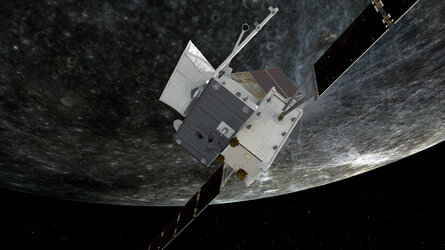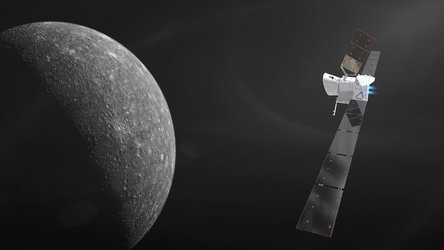Mercury’s magnetic landscape mapped in 30 minutes
As BepiColombo sped past Mercury during its June 2023 flyby, it encountered a variety of features in the tiny planet’s magnetic field. These measurements provide a tantalising taste of the mysteries that the mission is set to investigate when it arrives in orbit around the Solar System’s innermost planet.
Like Earth, Mercury has a magnetic field, albeit one hundred times weaker at the surface of the planet. Nonetheless, this magnetic field carves out a bubble in space, called a magnetosphere, which acts as a buffer to the continuous flow of particles blown out by the Sun as the solar wind. Because Mercury orbits so close to the Sun, the interaction of the solar wind with the magnetosphere and even the surface of the planet is a lot more intense than at Earth. Exploring the dynamics of this bubble and the properties of the particles contained within it is one of the main aims of BepiColombo’s mission.

BepiColombo is set to arrive at Mercury in 2026 using flybys of Earth, Venus and Mercury itself to adjust its speed and trajectory to allow it to be captured into orbit around the planet. The currently ‘stacked’ spacecraft will separate and deploy two science orbiters – the ESA-led Mercury Planetary Orbiter (MPO) and the JAXA-led Mercury Magnetospheric Orbiter (MMO, or Mio) – into complementary orbits to enable the essential dual-spacecraft measurements needed to paint a complete picture of Mercury’s dynamic environment.
As the spacecraft speeds past Mercury during the flybys, many of its science instruments are able to sneak a preview of the exciting science to come. Moreover, the flybys provide unique insights from regions around the planet that won’t be directly accessible from orbit.
Lina Hadid, a former ESA Research Fellow now at the Laboratoire de Physique des Plasmas at Paris Observatory, used the Mercury Plasma Particle Experiment (MPPE) suite of instruments active on Mio during the 19 June 2023 flyby, BepiColombo’s third of six Mercury gravity assists, to build up an impressive picture of the planet’s magnetic landscape in a very short period of time.
“These flybys are fast; we crossed Mercury’s magnetosphere in about 30 minutes, moving from dusk to dawn and at a closest approach of just 235 km above the planet’s surface,” she describes. “We sampled the type of particles, how hot they are, and how they move, enabling us to clearly plot the magnetic landscape during this brief period.”

Combining BepiColombo’s measurements with computer modelling to determine the origin of the detected particles based on their motion enabled Lina and her colleagues to sketch out the various features encountered in the magnetosphere.
“We saw expected structures like the ‘shock’ boundary between the free-flowing solar wind and the magnetosphere, and we also passed through the ‘horns’ flanking the plasma sheet, a region of hotter, denser electrically charged gas that streams out like a tail in the direction away from the Sun. But we also had some surprises."
Lina is the lead co-investigator of MPPE and lead of one of its instruments, the Mass Spectrum Analyser. She worked on the paper presenting the results with former instrument lead Dominique Delcourt.
“We detected a so-called low-latitude boundary layer defined by a region of turbulent plasma at the edge of the magnetosphere, and here we observed particles with a much wider range of energies than we’ve ever seen before at Mercury, in large thanks to the sensitivity of the Mass Spectrum Analyser designed especially for Mercury’s complex environment,” he says. “BepiColombo will be able to determine the ion composition of Mercury’s magnetosphere in greater detail than ever.”
“We also observed energetic hot ions near the equatorial plane and at low latitude trapped in the magnetosphere, and we think the only way to explain that is by a ring current, either a partial or complete ring, but this is an area that is much debated,” adds Lina.
A ring current is an electric current carried by charged particles trapped in the magnetosphere. Earth has a well-understood ring current located tens of thousands of kilometres from its surface. At Mercury it is less clear how the particles can stay trapped within a few hundred kilometres of the planet, especially as the magnetosphere is squashed against the planet’s surface. This debate will likely be settled once MPO and Mio are collecting data full-time.

Lina and her colleagues also observed the direct interaction of the spacecraft with the surrounding space plasma. When the spacecraft is heated by the Sun it cannot detect the colder, heavy ions because the spacecraft itself gets electrically charged and repels them. But as the spacecraft moves through the planet’s nightside shadow, the charging is different, and suddenly a sea of cold plasma ions become visible. For example, it detected ions of oxygen, sodium and potassium, which were likely sent flying from the planet’s surface by micro-meteorite strikes or through interactions with the solar wind.
“It’s like we’re suddenly seeing the surface composition ‘exploded’ in 3D through the planet’s very thin atmosphere, known as its exosphere,” remarks Dominique. “It’s really exciting to start seeing the link between the planet’s surface and the plasma environment.”
“In this rare dusk-to-dawn sweep through the large-scale structure of Mercury’s magnetosphere we’ve tasted the promise of future discoveries,” says Go Murakami JAXA’s BepiColombo project scientist.
“The observations emphasise the need for the two orbiters and their complementary instruments to tell us the full story and build up a complete picture of how the magnetic and plasma environment changes over time and in space,” adds Geraint Jones, ESA BepiColombo project scientist.
“We can’t wait to see how BepiColombo will impact our broader understanding of planetary magnetospheres.”
Meanwhile, scientists are already digging into the data snatched during last month’s fourth close Mercury flyby while flight controllers are readying for the final two back-to-back flybys slated for 1 December 2024 and 8 January 2025, respectively.
Notes for editors
‘Mercury’s plasma environment after BepiColombo’s third flyby’ by Lina Z. Hadid et al is published today in Nature Communications Physics.
The results are based on measurements by the Mass Spectrum Analyser (MSA), Mercury Ion Analyser (MIA), and Mercury Electron Analyser (MEA), part of the Mercury Plasma Particle Experiment suite of instruments onboard the JAXA-led Mercury Magnetospheric Orbiter.
BepiColombo is a joint endeavour between ESA and the Japan Aerospace Exploration Agency (JAXA).
For more information, please contact:
ESA Media Relations
media@esa.int








